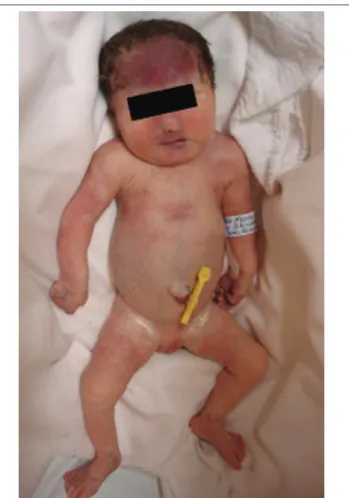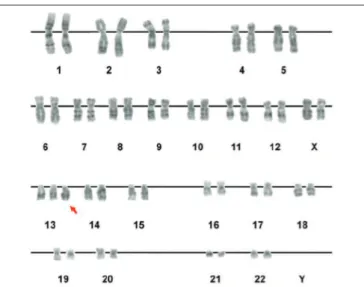229
CASE REPORTClinical utility of skin karyotype
Utilidade clínica do cariótipo de pele
Luiza E. Dorfman; Agnes F. R. P. Silva;Giorgio A. Paskulin; Rafael F. M. Rosa; Paulo R. G. Zen
Universidade Federal de Ciências da Saúde de Porto Alegre (UFCSPA).
First submission on 30/01/15; last submission on 03/03/15; accepted for publication on 21/05/15; published on 20/08/15
ABSTRACT
We report the case of a patient with Patau syndrome, diagnosed by skin karyotype, emphasizing the applications and importance of this test. The pregnancy morphology ultrasound showed face defects and of central nervous system and heart chambers asymmetry. In the postnatal evaluation it was identiied microcephaly, single central nostril, and other malformations. We performed skin karyotype that resulted in full trisomy 13. Our report highlights the possibility of performing karyotype examination in cases when it is no longer possible to obtain a blood sample, thus providing the correct diagnosis and genetic counseling for the family.
Key words: karyotype; ibroblasts; human chromosomes pair 13; chromosome aberrations; genetic counseling.
J Bras Patol Med Lab, v. 51, n. 4, p. 229-230, August 2015
INTRODUTION
Our aim was to report a case of a patient with trisomy 13 (Patau syndrome) diagnosed by skin karyotype, emphasizing the applications and importance of this exam. She was born vaginally at 34 weeks of gestation, weighing 1,700 g, with Apgar scores of 1 in the irst and ifth minutes. Her gestational ultrasound disclosed the presence of holoprosencephaly, ocular hypotelorism, microphthalmia, and left heart chambers asymmetry. In postnatal evaluation, it was also identiied microcephaly; single central nostril; micrognathia; small and abnormal ears; clitoromegaly; hypoplastic nails, and postaxial polydactyly of the right hand and
foot (Figure 1). She died soon after birth, before the possibility of blood sample collecting for karyotype analysis. However, it was possible to perform skin biopsy and karyotyping, because the child body had not yet been placed in formalin. This study was conducted following the protocol described by Paskulin et al.(1).
The result was consistent with the diagnosis of Patau syndrome due to full trisomy 13 (47,XX,+13) (Figure 2).
Trisomy 13 is considered a severe condition characterized by multiple malformations. The diagnosis in postnatal period is usually performed through conventional karyotype analysis using a sample of peripheral blood to obtain metaphase chromosomes(2).
The preference for this sample occurs due to its easily collection and cell culture, besides fast result. However, in some cases it is not possible to perform this kind of collection, as after the death of a newborn. Thus, the use of a skin biopsy for cytogenetic diagnosis may be an option in cases when it is not possible to obtain a
FIGURE 1 − Postnatal appearance of the patient. Note especially single nostril and right foot postaxial polydactyly
230
Clinical utility of skin karyotypeperipheral blood sample. Skin karyotype is also highly indicated in cases suspected of mosaicism by the presence of body asymmetries and hyper/hypo pigmented lesions following Blaschko’s lines(1).
Some care should be taken to maintain the material viability obtained from skin biopsy for cell culture. The sample must not be frozen or placed in formalin or alcohol, because this would make impossible the cell growth. The skin fragment should be stored
in a sterile bottle with saline solution or in a lask with culture medium supplied by the laboratory.
In Brazil, there are few cytogenetic laboratories able to perform the karyotype from skin culture, because this methodology presents greater dificulties in relation to the cultivation of peripheral blood. In addition, there are other factors that hinder the performance of this procedure, such as means of sample obtainment and demand of infrastructure for culture (as CO2 incubators and inverted microscope). It is important to be aware, however, that the time for obtaining the results of the skin culture is longer than the peripheral blood test (usually the release of a result takes approximately 1 month after collection). Moreover, skin culture has an increased risk of contamination compared with cultures from peripheral blood, which may interfere with the achievement of the results(3).
Currently there are faster and more eficient techniques for the detection of some chromosomal abnormalities, such as array-comparative genome hybridization (CGH). However, array-CGH, differently from skin karyotype, does not detect some alterations, as low grade mosaicisms, and it is usually not accessible to patients in Brazil due to its high cost.
Thus, our report emphasizes the possibility of karyotypical examination through skin biopsy in cases when it is not possible to obtain blood samples. This can provide the correct diagnosis and genetic counseling for the family.
REFERENCES
1. Paskulin GA, Lorenzen MB, Rosa, RFM, et al. Importance of the ibroblast chromosomal analysis in suspected cases of mosaicism: experience of a clinical genetics service. Rev Paul Pediatr. 2011; 29(1): 73-9.
RESUMO
Relatamos o caso de uma paciente com síndrome de Patau, diagnosticada por meio do cariótipo de pele, salientando as aplicações e a importância deste exame. Na ultrassonografia morfológica da gravidez, apresentou malformações de face, sistema nervoso central e assimetria de câmaras cardíacas. No pós-natal, identificou-se microcefalia e narina única central, além de outras malformações. Realizamos cariótipo de pele que resultou em trissomia livre do cromossomo 13. Nosso relato destaca a possibilidade da realização deste exame em casos nos quais não é mais possível a obtenção de amostra de sangue, proporcionando assim o correto diagnóstico e aconselhamento genético para a família.
Unitermos: cariótipo; fibroblastos; cromossomos humanos par 13; aberrações cromossômicas; aconselhamento genético.
2. Petry P, Polli JB, Mattos VF, et al. Clinical features and prognosis of a sample of patients with trisomy 13 (Patau syndrome) from Brazil. Am J Med Genet A. 2013; 161A(6): 1278-83. PMID: 23613355.
3. Barch MJ. The ACT cytogenetics laboratory manual. 2. ed. New York, NY: Raven Press; 1991.
MAILING ADDRESS
Paulo Ricardo G. Zen

